Android version 6.0: Marshmallow
In the grand scheme of things, 2015's Marshmallow was a fairly minor Android release — one that seemed more like a 0.1-level update than anything deserving of a full number bump. But it started the trend of Google releasing one major Android version per year and that version always receiving its own whole number.
Marshmallow's most attention-grabbing element was a screen-search feature called Now On Tap — something that, as I said at the time, had tons of potential that wasn't fully tapped. Google never quite perfected the system and ended up quietly retiring its brand and moving it out of the forefront the following year.
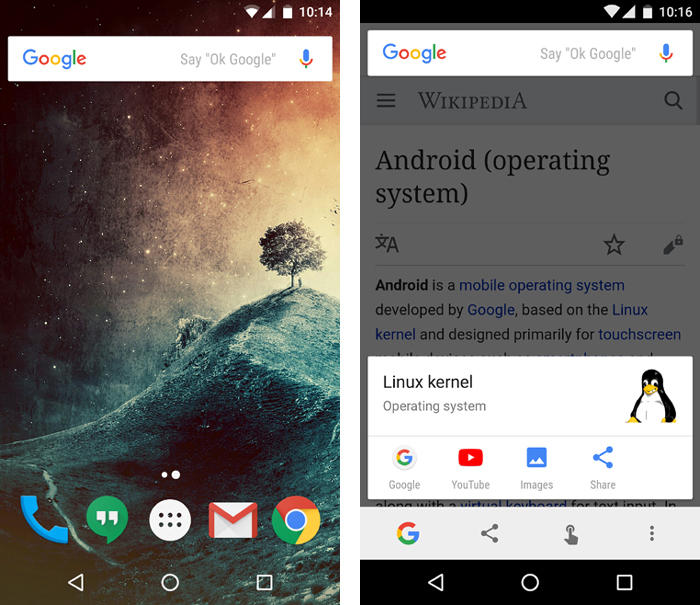 JR Raphael / IDG
JR Raphael / IDG
Marshmallow and the almost-brilliance of Google Now on Tap.
Android 6.0 did introduce some stuff with lasting impact, though, including more granular app permissions, support for fingerprint readers, and support for USB-C.
Android versions 7.0 and 7.1: Nougat
Google's 2016 Android Nougat releases provided Android with a native split-screen mode, a new bundled-by-app system for organizing notifications, and a Data Saver feature. Nougat added some smaller but still significant features, too, like an Alt-Tab-like shortcut for snapping between apps.
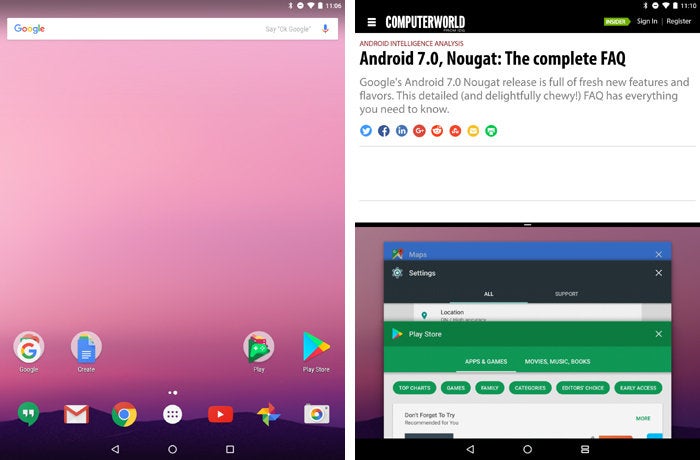 JR Raphael / IDG
JR Raphael / IDG
Android 7.0 Nougat and its new native split-screen mode.
Perhaps most pivotal among Nougat's enhancements, however, was the launch of the Google Assistant — which came alongside the announcement of Google's first fully self-made phone, the Pixel, about two months after Nougat's debut. The Assistant would go on to become a critical component of Android and most other Google products and is arguably the company's foremost effort today.
Android version 8.0 and 8.1: Oreo
Android Oreo added a variety of niceties to the platform, including a native picture-in-picture mode, a notification snoozing option, and notification channels that offer fine control over how apps can alert you.
 JR Raphael / IDG
JR Raphael / IDG
Oreo added several significant features to the operating system, including a new picture-in-picture mode.
The 2017 release also included some noteworthy elements that furthered Google's goal of aligning Android and Chrome OS and improving the experience of using Android apps on Chromebooks, and it was the first Android version to feature Project Treble — an ambitious effort to create a modular base for Android's code with the hope of making it easier for device-makers to provide timely software updates.
Android version 9: Pie
The freshly baked scent of Android Pie, a.k.a. Android 9, wafted into the Android ecosystem in August of 2018. Pie's most transformative change was its hybrid gesture/button navigation system, which traded Android's traditional Back, Home, and Overview keys for a large, multifunctional Home button and a small Back button that appeared alongside it as needed.
 JR Raphael/IDG
JR Raphael/IDG
Android 9 introduced a short-lived setup for getting around phones with a mix of both gestures and buttons.
Pie included some noteworthy productivity features, too, such as a universal suggested-reply system for messaging notifications, a new dashboard of Digital Wellbeing controls, and more intelligent systems for power and screen brightness management. And, of course, there was no shortage of smaller but still-significant advancements hidden throughout Pie's filling, including a smarter way to handle Wi-Fi hotspots, a welcome twist to Android's Battery Saver mode, and a variety of privacy and security enhancements.
Android version 10
Google released Android 10 — the first Android version to shed its letter and be known simply by a number, with no dessert-themed moniker attached — in September of 2019. Most noticeably, the software brought about a totally reimagined interface for Android gestures, this time doing away with the tappable Back button altogether and relying on a completely swipe-driven approach to system navigation.
Android 10 packed plenty of other quietly important improvements, including an updated permissions system with more granular control over location data along with a new system-wide dark theme, a new distraction-limiting Focus Mode, and a new on-demand live captioning system for any actively playing media.
 JR Raphael/IDG
JR Raphael/IDG
Android 10's new privacy permissions model added some much-needed nuance into the realm of location data.
Android version 11
Android 11, launched at the start of September 2020, was a pretty substantial Android update both under the hood and on the surface. The version's most significant changes revolve around privacy: The update built upon the expanded permissions system introduced in Android 10 and added in the option to grant apps location, camera, and microphone permissions only on a limited, single-use basis.
Android 11 also made it more difficult for apps to request the ability to detect your location in the background, and it introduced a feature that automatically revokes permissions from any apps you haven't opened lately. On the interface level, Android 11 included a refined approach to conversation-related notifications along with a new streamlined media player, a new Notification History section, a native screen-recording feature, and a system-level menu of connected-device controls.
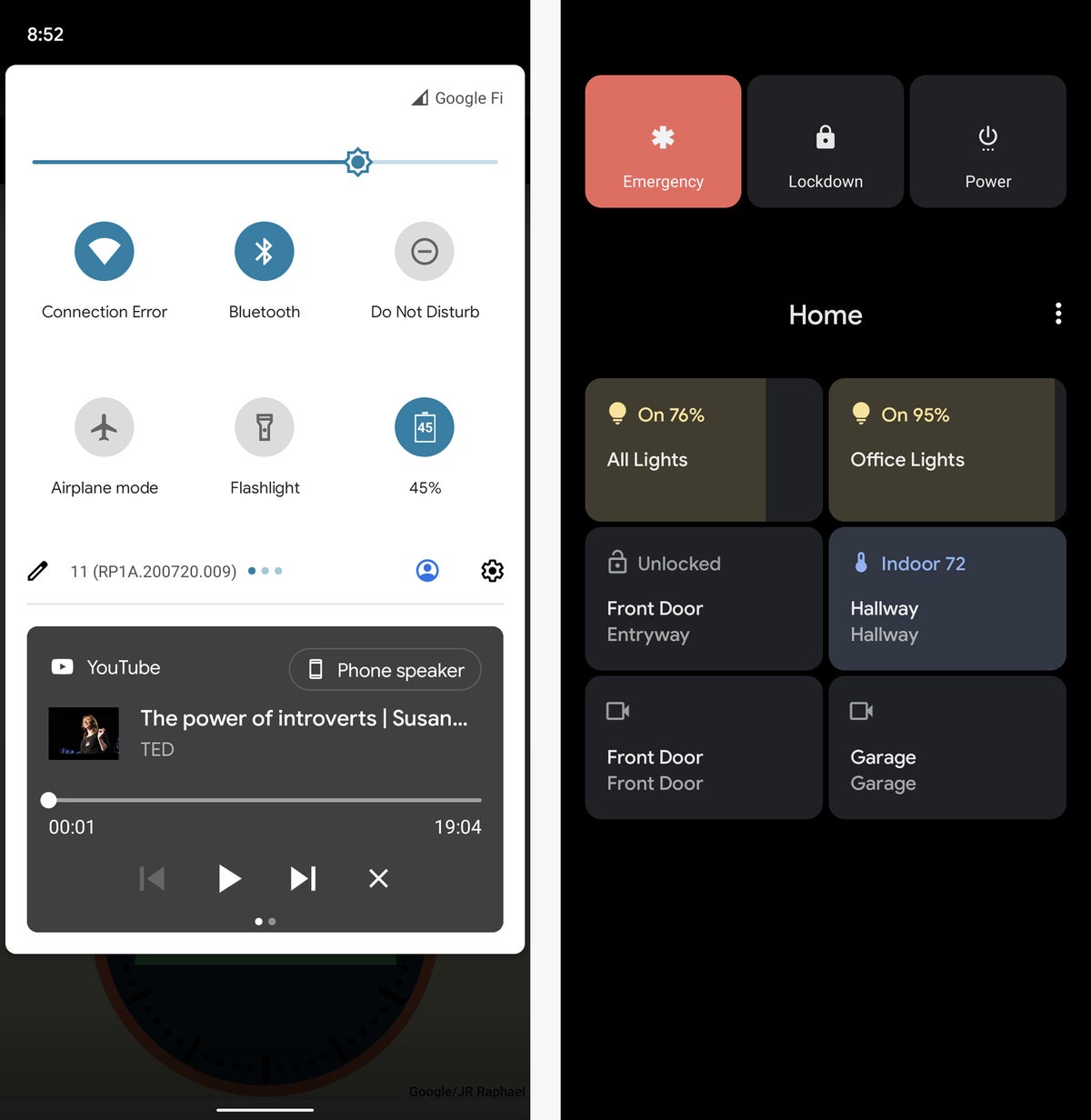 JR Raphael/IDG
JR Raphael/IDG
Android 11's new media player brought audio controls into the Quick Settings panel, while the new connected-device controls appeared within the system-level power menu.
Android version 12
Google officially launched the final version of Android 12 in October 2021, alongside the launch of its Pixel 6 and Pixel 6 Pro phones.
In a twist from the previous several Android versions, the most significant progressions with Android 12 were mostly on the surface. Android 12 featured the biggest reimagining of Android's interface since 2014's Android 5.0 (Lollipop) version, with an updated design standard known as Material You — which revolves around the idea of you customizing the appearance of your device with dynamically generated themes based on your current wallpaper colors. Those themes automatically change anytime your wallpaper changes, and they extend throughout the entire operating system interface and even into the interfaces of apps that support the standard.
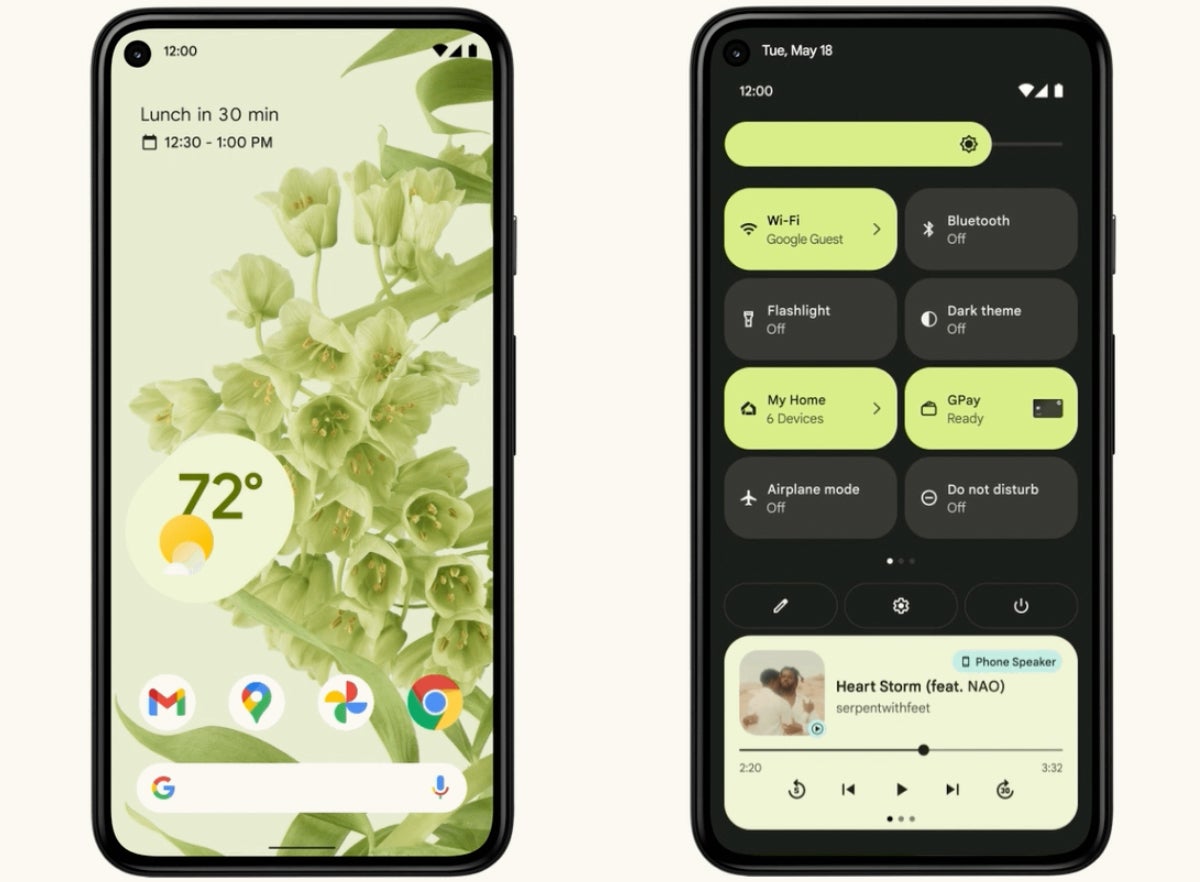 Google
Google
Android 12 ushered in a whole new look and feel for the operating system, with an emphasis on simple color customization. (Click image to enlarge it.)
Surface-level elements aside, Android 12 brought a (long overdue) renewed focus to Android's widget system along with a host of important foundational enhancements in the areas of performance, security, and privacy. The update provided more powerful and accessible controls over how different apps are using your data and how much information you allow apps to access, for instance, and it included a new isolated section of the operating system that allows AI features to operate entirely on a device, without any potential for network access or data exposure.
Android version 13
Android 13, launched in August 2022, is one of Google's strangest Android versions yet. The software is simultaneously one of the most ambitious updates in Android history and one of the most subtle version changes to date. It's an unusual duality, and it ultimately all comes down to what type of device you're using to experience the software.
On the former front, Android 13 introduces a whole new interface design for both tablets and foldable phones, with a renewed focus on creating an exceptional large-screen experience in the operating system itself and within apps (as first observed and reported by Computerworld in January). The enhancements in that area include a fresh framework and series of guidelines for app optimizations along with a more capable split-screen mode for multitasking and a ChromeOS-like desktop-style taskbar that makes it easy to access frequently used apps from anywhere — enhancements we now know were aimed initially at Google's Pixel Fold and Pixel Tablet devices, though their impact and effects have certainly stretched beyond those two products.
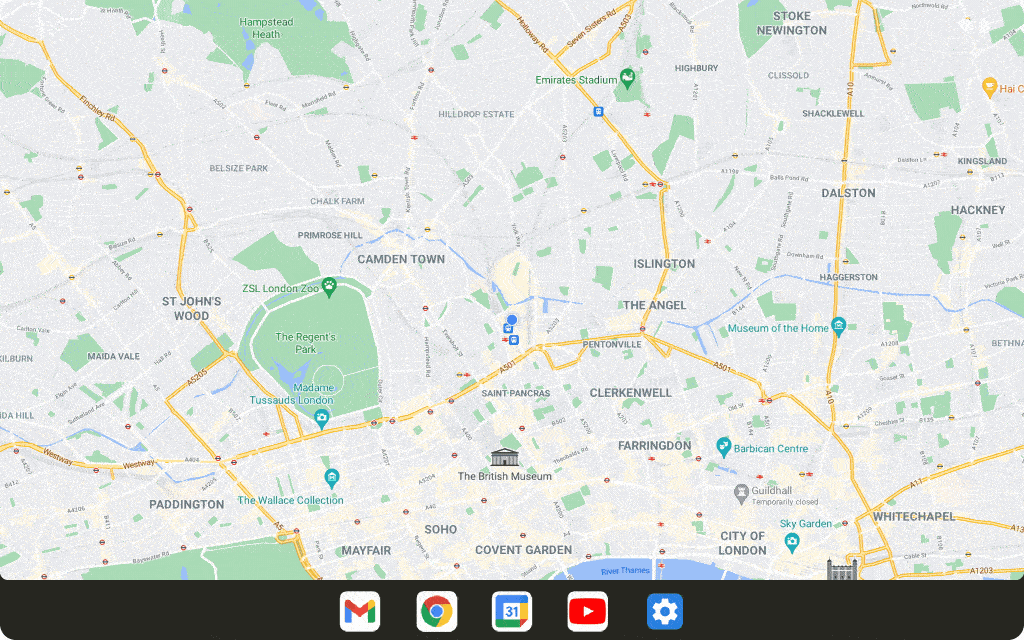 Google/JR Raphael
Google/JR Raphael
Android 13 introduces a more desktop-like multitasking setup for tablets and foldable phones.
On the latter front, Android 13 also laid the groundwork for the Pixel Tablet to function as a stationary Smart Display and then allow you to detach its screen and use it as a tablet. The software introduced support for a whole new series of shared-surface widgets and screensavers along with an expanded multiuser profile system for that purpose.
On regular phones, Android 13 is much less significant — and in fact, most people probably won't even notice its arrival. Along with some minor visual refinements, the software introduces an expanded clipboard system that allows you to see and edit text as it's copied, a native QR code scanning function within the Android Quick Settings area, and a smattering of under-the-hood improvements connected to privacy, security, and performance.
Android version 14
Following a full eight months of out-in-the-open refinement, Google's 14th Android version landed at the start of October 2023 in the midst of the company's Pixel 8 and Pixel 8 Pro launch event.
Like the version before it, Android 14 doesn't look like much on the surface. That's in part because of the trend of Google moving more and more toward a development cycle that revolves around smaller ongoing updates to individual system-level elements year-round — something that's actually a significant advantage for Android users, even if it does have an awkward effect on people's perception of progress.
But despite the subtle nature of its first impression, Android 14 includes a fair amount of noteworthy new stuff. The software introduces a new system for dragging and dropping text between apps, for instance, as well as a new series of native customization options for the Android lock screen.
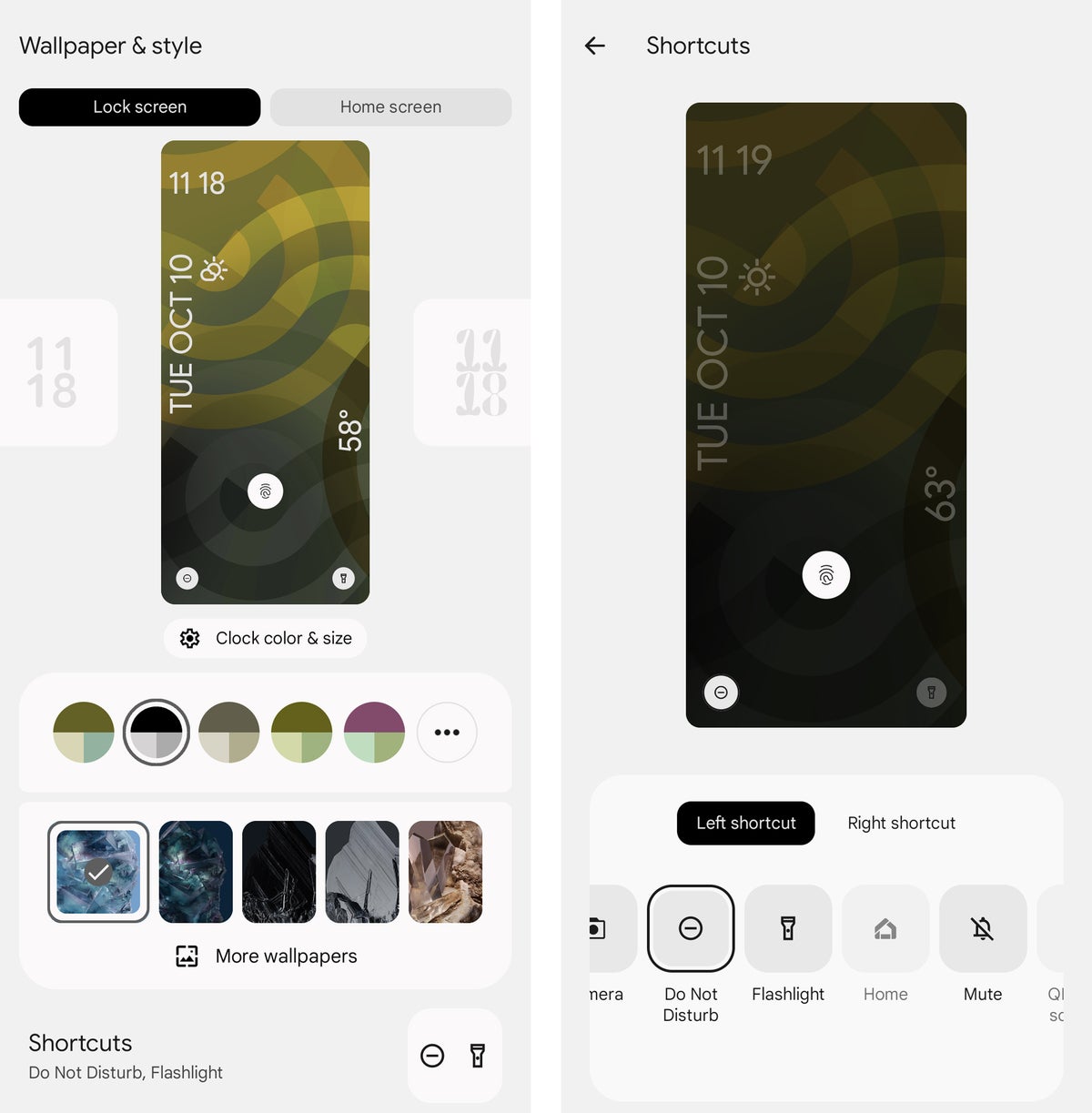 JR Raphael / IDG
JR Raphael / IDG
Android 14 includes options for completely changing the appearance of the lock screen as well as for customizing which shortcuts show up on it.
Android 14 provides a number of new improvements to privacy and security, too, including a new settings-integrated dashboard for managing all your health and fitness data and controlling which apps and devices can access it. And it adds in a more info-rich and context-requiring system for seeing exactly why apps want access to your location when they request such a permission.
The software also sports a series of significant accessibility additions, such as an enhanced on-demand magnifier, an easier way to increase font size in any app, improved support for hearing aid connections, and a built-in option to have your phone flash its camera light anytime a new notification arrives.
Beyond that, Android 14 features a first taste of Google's AI-generated custom wallpaper creator, though that's available only on the Pixel 8 and Pixel 8 Pro to start.
 JR Raphael / IDG
JR Raphael / IDG
You can generate all sorts of interesting wallpapers in seconds via Android 14's AI generator feature — but only on the Pixel 8 or Pixel 8 Pro for now.
Android 14 started rolling out to Google's current Pixel phones in early October, on the day of its release. If past Android upgrade trends are any indication, it'll likely reach the first non-Google-made devices later this year and then continue rolling out slowly to more phones and tablets as the months progress.
This article was originally published in November 2017 and most recently updated in October 2023.












